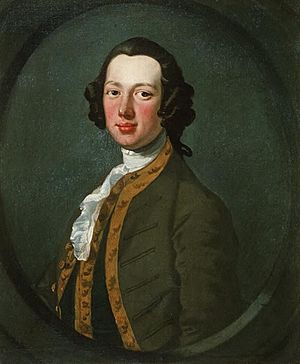Walter Griffith facts for kids
Quick facts for kids
Walter Griffith
|
|
|---|---|
 |
|
| Died | 18 December 1779 |
| Allegiance | |
| Service/ |
Royal Navy |
| Rank | Post-captain |
| Commands held |
|
| Battles/wars | |
Walter Griffith was an important officer in the Royal Navy during the American War of Independence. He was known for his bravery and skill at sea.
Contents
Who Was Walter Griffith?
Walter Griffith came from an old family in Merionethshire, a region in Wales. He joined the Royal Navy and quickly rose through the ranks. His career showed his dedication to serving his country at sea.
Griffith became a lieutenant in the navy on May 7, 1755. He served on several ships, including the 60-gun Eagle. Later, he was on the huge 100-gun HMS Royal George. This ship carried the flag of Lord Anson, a very important admiral. Griffith also served under Sir Edward Hawke, another famous naval leader.
On June 4, 1759, Griffith was promoted to command the 18-gun sloop HMS Postilion. A sloop was a smaller, fast warship. He briefly commanded the 28-gun HMS Argo before returning to the Postilion.
Important Commands and Battles
Spotting the French Fleet
In September 1759, Griffith was given temporary command of HMS Gibraltar. This ship was part of a large British fleet watching the French navy near Brest. On November 15, he was lucky enough to spot the French fleet.
Griffith acted quickly and smartly. He sent detailed information about the French ships to Admiral Hawke and the Admiralty. The Admiralty was the main office in charge of the British Navy. He also warned Admiral Thomas Brodrick, who was blocking a port in Cadiz. His actions were highly praised by the Admiralty. They even told him he could expect a special reward soon. Because of his excellent work, he was officially made captain of the Gibraltar on December 11, 1759.
Fighting in the American War of Independence
Griffith stayed with the Gibraltar until 1766. He served in the Mediterranean Sea and then closer to home. In 1770, he briefly commanded the 90-gun HMS Namur.
In 1776, he was given command of the 64-gun HMS Nonsuch. Early the next year, he joined Lord Howe in North America. Here, he helped defend Sandy Hook from the French fleet led by D'Estaing in 1778.
He then sailed with Commodore William Hotham to the West Indies. There, he fought in the Battle of St. Lucia on December 15, 1778. He also took part in the Battle of Grenada in July 1779.
Final Battle and Legacy
When Admiral John Byron left his command, Griffith moved to the 74-gun HMS Conqueror. Just a few months later, on December 18, 1779, he was killed. This happened during a small fight with the French in Fort Royal Bay, known as the Battle of Martinique.
Rear-Admiral Hyde Parker wrote about Griffith's death, saying, "The service cannot lose a better man or a better officer." This shows how much he was respected by his fellow naval officers.

